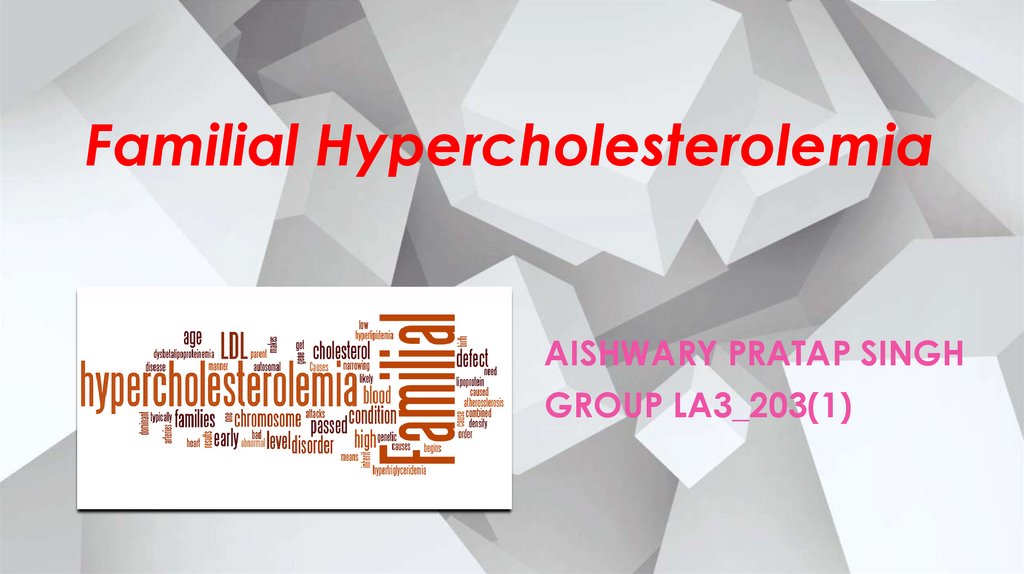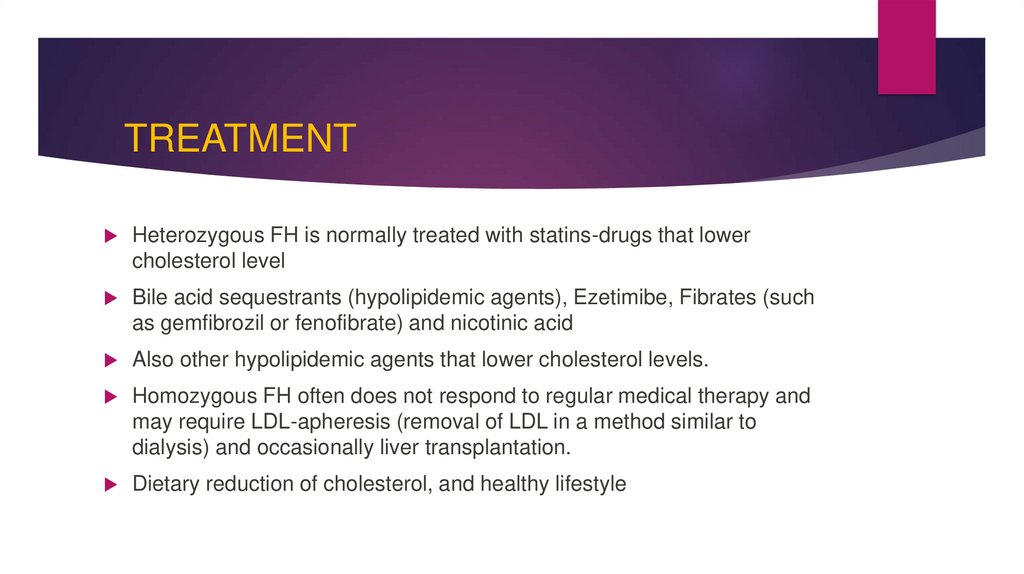Похожие презентации:
Familial Hypercholesterolemia
1.
Familial HypercholesterolemiaAISHWARY PRATAP SINGH
GROUP LA3_203(1)
2.
IntroductionFamilial hypercholesterolemia (FH) have raised cholesterol levels in
blood with a significant risk of developing early CAD.
FH is an autosomal dominant disorder occurs in 1 in 500 individuals.
Usually due to mutations in LDL receptor gene that result in decreased
clearance of LDL particles from plasma
Other mutations include those in the Apo B ,ARH and PCSK9 genes
3.
CLINICAL MANIFESTATIONSHigh cholesterol level in blood.
Heterozygotes may have premature cardiovascular disease
at the age of 30 to 40.
homozygous may cause severe cardiovascular disease in
childhood.
Accompanied by cholesterol deposition in tendons and skin
(xanthomas) and in the eyes
4.
A- XanthelasmaB – Corneal arcus (Arcus
senilis)
C - Achilles tendon
xanthomas
D - Tendon xanthomas
E - Tuberous xanthomas
F - Palmar xanthomas
5.
PLASMA CHOLESTEROL LEVEL INNORMAL AND FH INDIVIDUALS
NORMAL – 150 – 200 mg/dl
FH HETEROZYTOGE – 200 – 500 mg/dl
FH HOMOZYGOTES – 600 – 1000 mg/ dl
6.
Function of LDLR geneThe LDLR gene provides instructions for making a protein called
low density lipoprotein receptor
This receptor binds to particles called low-density lipoproteins,
which are the primary carriers of cholesterol in the blood.
They are particularly abundant in the liver, which is the organ
responsible for removing most excess cholesterol from the body.
7.
Mutation in LDLR geneMutations in the LDLR gene cause FH
More than 1,000 mutations have been identified in this gene.
Some genetic changes reduce the no. of low-density lipoprotein receptor and other
mutations disrupt the receptor's ability to remove low-density lipoproteins from the
blood.
As a result, people with mutations in the LDLR gene have very high blood cholesterol
levels.
The excess cholesterol circulates through the bloodstream, is deposited abnormally in
tissues such as the skin, tendons.
And also arteries that supply blood to the heart (coronary arteries) results in heart
attack.
8.
9.
10.
CLASSES OF MUTATION IN LDLRClass 1 mutations affect the synthesis of the receptor in the endoplasmic
reticulum (ER).
Class 2 mutations prevent proper transport to the Golgi body needed for
modifications to the receptor
Class 3 mutations stop the binding of LDL to the receptor..
Class 4 mutations inhibit the internalization of the receptor-ligand complex
Class 5 mutations give rise to receptors that cannot recycle properly. This leads to
a relatively mild phenotype as receptors are still present on the cell surface
Class 6 Failure to localize receptor to the basolateral domain
11.
Mutation in APOE geneAt least five mutations in the APOB gene are known to cause
a form of inherited hypercholesterolemia.
2. Each mutation that causes this condition changes a single
amino acid in a critical region of apolipoprotein B-100.
3. The altered protein prevents low-density lipoproteins from
effectively binding to their receptors on the surface of cells.
1.
4.
As a result, fewer low-density lipoproteins are removed from
the blood, and cholesterol levels are much higher than
normal.
12.
Function of LDLRAP1 GeneThe LDLRAP1 gene is located on 1p36-p35.
The LDLRAP1 gene is also known as ARH( Autosomal recessive
hypercholesterolemia)
The LDLRAP1 gene provides instructions for making a protein LDLRAP1 that
helps remove cholesterol from the bloodstream.
The LDLRAP1 protein interacts with a protein called a low-density lipoprotein
receptor.
The LDLRAP1 protein appears to play a critical role in moving these receptors,
together with their attached low-density lipoproteins, from the cell surface to the
interior of the cell.
13.
Mutation in LDLRAP1 geneMore than 10 mutations in the LDLRAP1 gene have been shown
to cause a form of inherited high cholesterol called ARH
These mutations lead to the production of an abnormally small,
nonfunctional version of the LDLRAP1 protein or prevent cells from
making any of this protein.
Without the LDLRAP1 protein, LDL receptors are unable to remove
LDL’s from the bloodstream effective.
The receptors can still bind normally to low-density lipoproteins,
but not properly transported into cells . As a result, more lowdensity lipoproteins remain in the blood.
14.
FUNCTION OF PCSK9 GENEThe PCSK9 protein appears to control the number
of low-density lipoprotein receptors, which are
proteins on the surface of cell
the PCSK9 protein helps control blood cholesterol
levels by breaking down low-density lipoprotein
receptors before they reach the cell surface
15.
TREATMENTHeterozygous FH is normally treated with statins-drugs that lower
cholesterol level
Bile acid sequestrants (hypolipidemic agents), Ezetimibe, Fibrates (such
as gemfibrozil or fenofibrate) and nicotinic acid
Also other hypolipidemic agents that lower cholesterol levels.
Homozygous FH often does not respond to regular medical therapy and
may require LDL-apheresis (removal of LDL in a method similar to
dialysis) and occasionally liver transplantation.
Dietary reduction of cholesterol, and healthy lifestyle

























